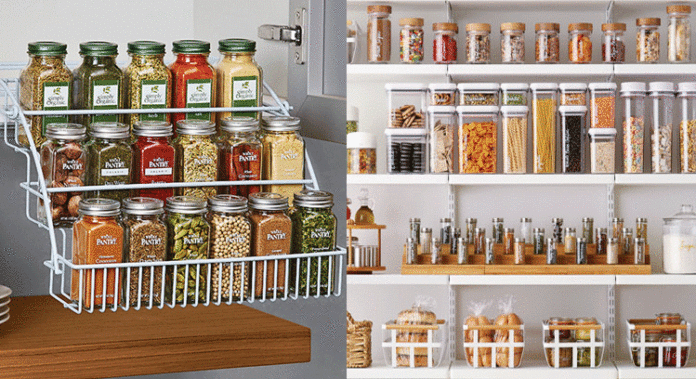
TRADITIONALLY THE heart of the home, kitchens tend to get even more use at this time of year. Whether you need room to roast a joint of beef or easy access to ingredients, here’s a few tips on how to make the most of your space.
1. Compartmentalise your cupboards
To keep your kitchen cupboards from becoming a jumble of boxes, bags and cans, gather some flat-bottomed rectangular baskets or small wooden or cardboard boxes – shoe boxes are usually ideal. Line up the containers on the shelves and reserve each for a different kind of food—one for sugar, syrups and other sweet things, one for baking-related items like flour and bicarbonate of soda and so on. If you use boxes, you can paint them to blend with your kitchen’s colour scheme. Whether you decorate them or not, label the containers with their contents so you don’t confuse sugar with salt.
2. Organise spices by style of cuisine
Is your spice rack a mess? Can’t find the cumin when you need it? Arrange spice bottles in a low-sided, unlidded box (old cigar boxes work brilliantly) by type of cuisine. So whenever you’re cooking Italian food (or Chinese, French, Thai, Indian or Middle Eastern), the appropriate spices will be together in one place. Cumin, tamarind, coriander and chillies? Probably Indian or Thai. Tarragon, parsley, sorrel and bay? French. Label each box according to its nationality and hopefully, whenever you’re in the mood for that style of cuisine, your search for the right spices will be kept to a minimum.
3. Newspaper buffers for non-stick cookware
When you nest non-stick saucepans one inside the other in kitchen cupboards, it’s very easy to scratch the delicate coating. Keep your nonstick cookware scratch-free by simply tucking a newspaper sheet between each pot.
4. Storing fine china safely
When stacking fine china in the cupboard, keep dinner plates scratch-free by alternating them with paper plates. For salad plates and saucers, use coffee filters. China teacups are best stored right-side up. If the cupboard won’t take all the cups, create an extra tier of shelf space by putting a plastic-coated wire rack inside. But why not hang the cups from hooks attached to the bottom of the shelf above? Hooks are fine for everyday china, but hanging antique teacups means that they will be bearing their own weight—a bad idea if you want to give these heirlooms the tender loving care they deserve.
5. Sheathe your kitchen knives
Sharp cooking knives can be dangerous, so never keep them loose in a drawer. If you don’t have benchtop space for a knife holder, create protective sheaths for knives from cardboard tubes (from paper towels and plastic wrap, etc.). Just flatten a tube, fold over one end and staple or tape it closed, then slide a knife in the other end. For smaller knives, use toilet paper tubes.








